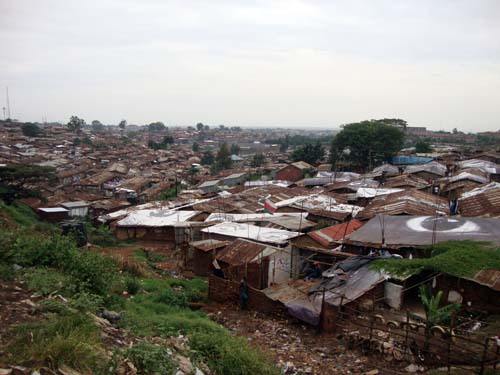
I’ve been on a 3-day shopping tour of sorts in Nairobi. Not so much to purchase goods but more to research and learn about the people behind the beautiful crafts and curios sold around Kenya. I took my friend John from the village with me; I want to expose him to as much as I can and I also appreciate his assistance with translation and questioning at times.
Day One (Thursday):
By the time 7am rolled around, I think John and I had been in and out of consciousness for a few hours. Staying at a shoddy hotel right downtown near the main public transportation hub and lots of bars, the noise in the alley below was buzzing late into the night and started again very early in the morning. We walked downstairs for our complimentary breakfast (okay the fact that this place is called a bed and breakfast is laughable because it’s definitely a hole in the wall). We… or I guess I should say I, decided to visit a women’s group in Kibera called Power Women on our first morning. Kibera is the largest slum in Kenya and the second largest in Africa. If you read online, it’s not recommended that you venture into Kibera without a local, but a.) the group’s website had independent directions and they sounded easy and b.) I had a Kenyan with me, which makes me appear to be with a local for the most part. We picked up bus 32 by the Hilton and asked the driver to tell us when we reached the Olympic Stage. The bus wound it’s way past several ugly office buildings, a park, and some typical Nairobi sites. Then, the landscape suddenly changed, and when I saw the rusted metal shanties, I knew we were entering Kibera. Suddenly, I got butterflies in my stomach. This isn’t my first, or even second, visit to a slum in Nairobi. However, I have always been escorted by a local. It wasn’t about safety. I operate under the general assumption that people are not out to harm me. But I was more concerned about how much I would stick out and whether or not there would be a level of acceptance. Would they think I was there to look at the place as if it were a zoo? Would they wait for me to pull out my camera and try to take photos? Or look at the area in disgust? I was nervous. I apprehensively climbed down the bus steps and turned 360 degrees in search for the Olympic Primary School, a landmark in my directions. I didn’t see it, so I stopped a man in front of me. He told me to head straight down the road and took me to the center of the street to point out the fence in the distance. I thanked him and we started walking. I felt very few people staring… less even than I think stare at me back in my village.
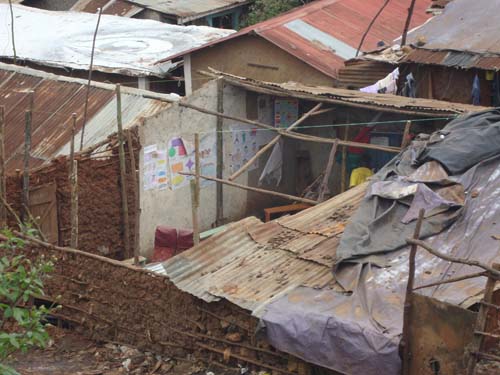
When we reached the primary school, I did not see the women’s shop but instead saw a painted gate that described a day care, nursery school, and women’s handicraft inside. We stared at the gate for a minute debating whether to check it out. Then a woman passed and noted in Swahili that people were inside. We reached under the metal flap of the solid gate to undo the latch. We opened the gate and approached the door of the house. Two women stood there and I asked in an unconfident tone if they sold beadwork. They told me, ‘Yes.’ I asked if they had some inside. They, again, told me, ‘Yes.’ Unsure as to whether I should invite myself in, I asked if I could see it, and suddenly they warmed up. The women at this school only do beadwork when school is in session, so these two were there only to clean that day. They had very few examples available since school wasn’t in session. We exchanged information and I told them I would try to visit in January when the school is open. Dorcas, one of the women, grabbed a beaded ring and gave it to me ‘for stopping by.’ I tried to refuse but she insisted. Now how’s that for hospitality?
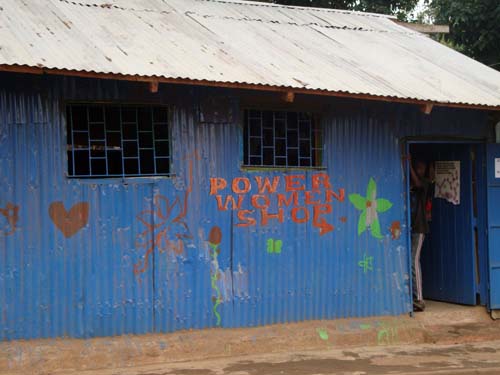
We asked her about our next landmark, Carolina for Kibera, and the women told me that it was where they had been trained to open up their daycare and nursery. We found the organization but unfortunately, the shop was not right in front of it, as the directions said. I went up to the askari (the security guard) and asked him about a women’s handicraft group that might be located nearby. He smiled and said, “Oh you must mean Power Women. It’s down there in the blue building.” We entered the shop, and I saw two women sitting to the side. When I went to greet them and shake hands, they pulled out two chairs for John and I to sit down. It was great because I wanted to find out more about their business, but how many shops do you walk in where you are offered a chair to sit and get to know each other? We wasted no time, and since I couldn’t really contain my excitement I just said, “I want to learn about your project and how it started.” Elizabeth, who I later found out, is the Chairwoman, started to explain. As she spoke, Doreen, the other woman, got up and grabbed products that related to Elizabeth’s story. So it goes something like this:
Elizabeth and the other women met at an NGO that works with women living with HIV/AIDS. All of the women and some of their children are ‘living positively’. In 2004, the women wanted to do something about the stigma against HIV/AIDS and decided to form a group. Each woman contributed 10 Ksh per week (about 12 cents) and at the end of two months the group had 3000 Ksh. They purchased supplies to make little beaded pins with the red ribbon symbol on them. However, the women learned that they could not sell them except around the time of December 1st, when it is World AIDS Day. One of the women saw a beaded necklace at Nakumatt (a supermarket here in Kenya) and showed the other women how to make it. After that, all of the women had to come with a design and show everyone how to make it. The shop opened in 2005 and the group now has 20 women.
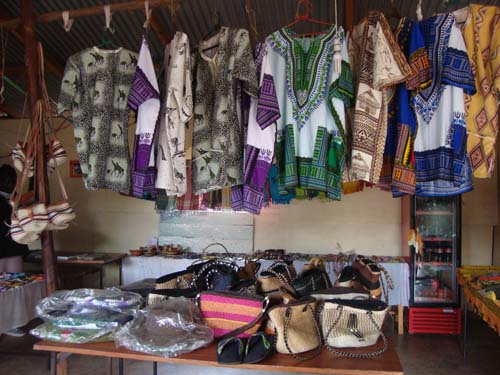
Though the women still struggle, they have an amazing system and camaraderie (I may have fired question after question at them, but I am so grateful that they were more than happy to answer them all!). The money they receive from sales goes to four things. One: To purchase materials to make more products. Two: To purchase food for breakfast and lunch that the women can come to the shop to eat daily. This way, every woman is guaranteed a meal to be able to take her ARV medication. Three: For emergency situations should a woman or a member of her family becomes ill or if there is a death in the family. Four: To pay the women for living expenses such as rent, food, and children’s school fees.
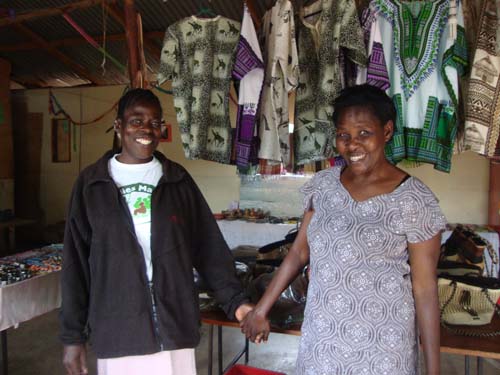
Power Women recently purchased the building they are operating in now, and it has an extra room. They are thinking of turning it into a salon to earn additional income. John and I walked around and looked at all of their products. I asked Elizabeth and Doreen if I could take a picture of them and they agreed. I pulled out my camera and when I looked up, they are smiling and holding hands. The bond these women have appears to be unshakeable and so very genuine. John and I left the shop feeling nothing but admiration for these women and fiercely motivated to pursue our goals for the future. We wanted to walk around and explore the area. We reached the train tracks (yes, a train runs right through Kibera) and got a view of the density of Kibera. We paused to take it in, and I took a few photos. I was intrigued by the tarps on some of the roofs with a pair of eyes. After asking several shopkeepers, we found out that the tarps were placed there for a documentary or movie about Kibera. I noted to John as we walked around that hardly anyone yelled “Muzungu” and not a soul had come up to ask me for money. I was quite surprised. A gentleman even lovingly pushed his children up to greet me. We walked passed a bulldozer working on improving a dirt road, when a woman stopped John in the street. The two of them are conversing, and I’m afraid that I’ve spoken too soon. I’m waiting for John to translate and assume she is asking for money or food. Finally, John turns to me and says, “This woman says she is… (he paused to speak in a more hushed tone) living with HIV and someone told her she shouldn’t have any sugar. So, she wants to know what fruits don’t have sugar.” John and I encourage her to continue to eat fruits and only trust the advice of her doctor. I’m the last person people should ask for medical advice, but thankfully, I knew the answer to this one. She didn’t want a handout- just information. I further felt faith in Kibera and its people.
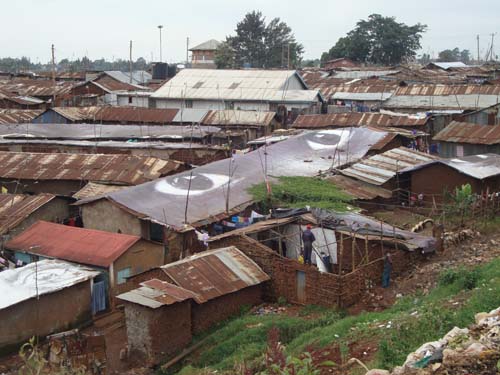
We stopped in Kibera’s local market to pick up some blankets and headed back to the city centre to drop them off. Then, it was off to find another bus to head out to an area called Westlands. There are two higher-end shops I wanted to visit there, but realizing I left my map at the hotel, we just dropped in at the mall. We grabbed lunch at the food court and dicussed our thoughts of the morning. John was highly motivated by the women’s ability to collectively save a small amount of money each week and then use the small seed money to grow a business. He hopes to implement this idea with friends in his village for a different project. I was extremely impressed by the women’s ability to come up with their own idea and implement it when most people would claim to have nothing to give.
We spotted a huge crafts market across the street from the mall, which I had no idea existed. Trying to kill time before a movie started at the mall, we walked through and talked to several of the soapstone artists. As we left the crafts market with a few more ideas, we were shaken out of our bubble by several teenage boys sniffing glue– right out in the open. It’s extremely common among street children and those living in the slums here but I have never seen it outright and especially didn’t expect it in a nicer area of town. The reality of poverty is quite different from the romanticized photos of media. (Don’t get me wrong- I love National Geographic). We went back to the mall and wrapped up the long day by watching Sherlock Holmes 2.
Shopping/research day one in Nairobi: Extremely rewarding!
Note: Before venturing in to Kibera alone, please take safety into consideration. I don’t want to give the wrong idea- parts of Kibera are still extremely dangerous, and when I tried to visit a local friend’s project in a different neighborhood, he refused to escort me himself without an armed police officer. Kibera has 14 different neighborhoods and some areas are safer than others.
I’ve only been to Soweto and Kayole, do you know in relation to those two slums where Kibera is?
I believe both of those are east of of the city center, while Kibera is to the west. It’s just south of the area where Yaya Centre is.
Thanks Laura
What an amazing journey you have been on!
An eye-opener for me! in spite of the lack of resources , the power women can do a lot of things if we help one another.
Wow what an incredibly inspiring post! Happy New Year!!!
Just stumbled upon your blog. What an amazing and inspirational journey you are taking!
WOW. How amazing. These women need to start an Etsy shop!!